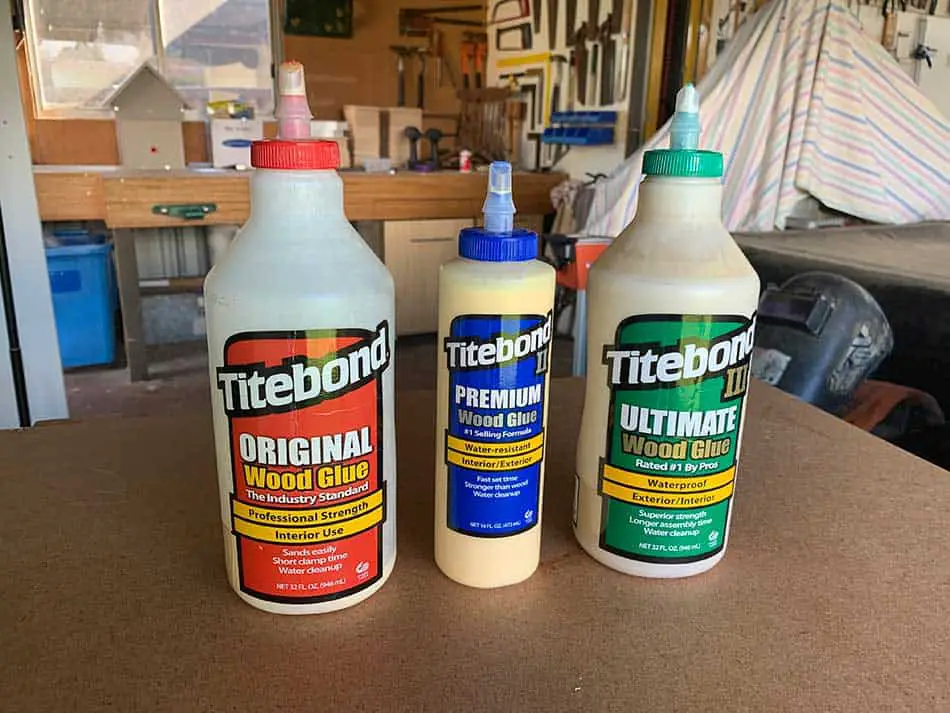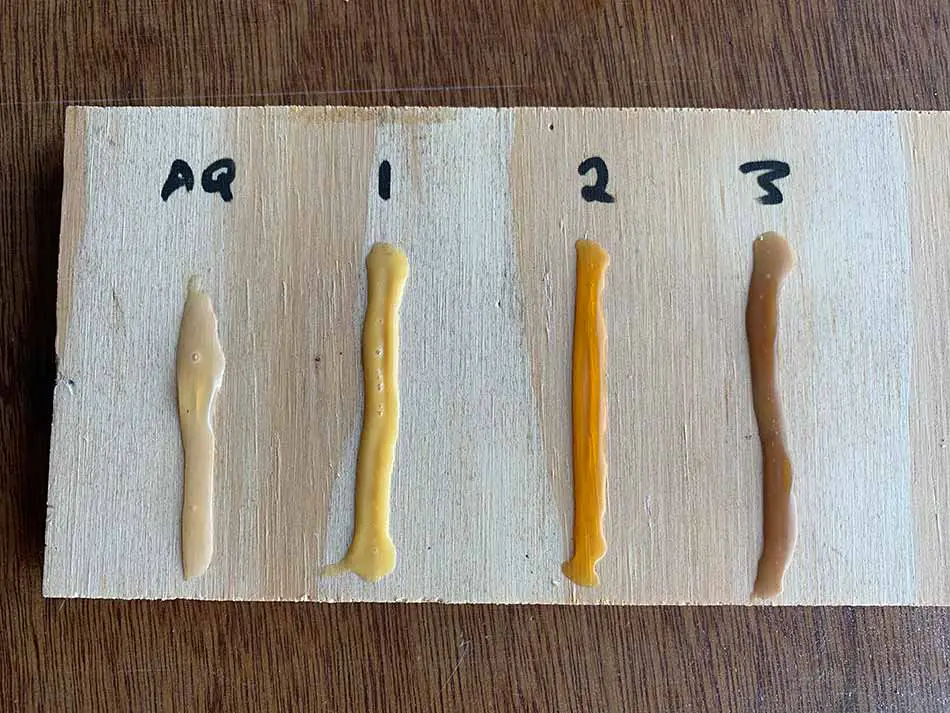So now it’s come time for you to glue up your project but with so many opinions about Titebond glues, does Titebond wood glue dry clear?
Titebond 1, 2 & 3 wood glue does not dry clear. The Titebond original dries to a slightly yellow color while Titebond 2 dries to dark yellow and Titebond 3 dries to a dark brown. The color variance is due to their water-resistant properties.
Titebond 1, 2 & 3 wood glue are some of the most popular amongst woodworkers so I tested them to see if they actually do dry clear. The results did surprise me with none of the 3 of them drying clear.
I will also briefly touch on which Titebond wood glues do dry clear.
Will You Have A Visible Glue Line?
This is an important factor to consider before doing your next glue up. You can ruin the look of a nice piece of furniture with dark glue lines.
If you are using light-colored wood, it is best to use Titebond Original and even Titebond 2 will work. If you intend to use a darker timber like Walnut then Titebond 3 is best.
I recommend Titebond as the best wood glue for cutting boards as the glue lines match so closely with the timber.
In most cases, the thickness of your glue line will generally only be 0.1mm at the most so your glue line should not be visible if you follow the above advice.
Make sure to clean away excess glue before it dries as Titebond wood glues do not take stain.
Below is a video I made that shows the difference in color when dried between Titebond 1, 2, and 3.

What Is The Difference Between Titebond 1, 2 & 3?
The main differences between Titebond 1, 2 & 3 are water resistance, strength, open time, and price. Titebond Orignal is best for indoor use while Titebond II and III have varying amounts of water resistance.
I will explain in more detail these differences in the below table so you can better understand which glue to use on your next project.
| Titebond Original | Titebond II | Titebond III | |
|---|---|---|---|
| Water Resistance | None | Resitant | Water Proof* |
| Strength | 3,600 psi | 3,750 psi | 4,000 psi |
| Open Time | 4-6 minutes | 3-5 minutes | 8-10 minutes |
| Assembly Time | 5 minutes | 5 minutes | 10 minutes |
| Viscosity | 3,200 cps | 4,000 cps | 4,200 cps |
| Dried Color | Off Yellow | Dark Yellow | Brown |
| Exterior Use | No | Yes | Yes |
| Price (16 ounce) | $10.68 | $12.00 | $14.90 |
| Food safe | No | Yes | Yes |
| Freeze Thaw Stable | Yes | Yes | Yes |
Which Titebond Glues Drys Clear?
- Titebond Translucent Wood glue is one glue that as the name suggests, does dry completely clear. It is perfect for any indoor project that requires an invisible glue joint or is perfect on light-colored woods.
It is also the perfect craft or hobby glue and can be sanded and finished easily. Amazon sells it for $8.50 for an 8-ounce bottle.
- Titebond Quick & Thick also dries somewhat clear but it is a 2 Pak glue that is best suited for different types of surfaces. The only problem I have found with Quick & Thick is it sets really quickly making it hard to work with. It also has a very thick consistency as the name suggests.
When in doubt, always test your wood glue on a scrap piece of timber first.

How Long Does It Take Titebond Wood Glue To Dry?
Titebond 1, 2 & 3 wood glues all take around 6 hours to fully dry. Titebond should be left in the clamps for a minimum of 45 minutes to ensure a good bond.
These results are obviously affected by the conditions inside your workshop. Before doing a glue-up ensure it is not too cold and you have sufficient air ventilation. These are very important factors as this can affect how long your glue takes to dry.
I made it which clearly shows you why your glue may not dry or takes longer than normal.
Which Titebond Glue Should You Use?
All of our woodworking projects are going to be slightly different and I can see why there is often some confusion over which Titebond glue to use.
I thought I would quickly summarize which glue suits which applications to make it easier for you on your next project.
- Titebond Original – This glue is an Aliphatic Resin glue. This is the glue I use most often. It is perfect for general softwood and hardwood glue-ups including edge gluing.
It is great for particleboard, MDF, plywood, and other porous materials. This glue is mostly used by instrument makers as well. Titebond Original can be cleaned up with water but it is not food safe.
- Titebond II – This glue is a cross-linking PVA. It is great for edge-to-edge gluing and face-to-edge gluing. Due to its cross-linking abilities, it is a little stronger than Titebond Original.
It can also be used for High frequency or hot and cold presses. Titebond II sets quickly and is food safe. It has a level of water resistance meaning that a dried joint can cope with some water exposure over time.
- Titebond III (Ultimate) – This glue is a Proprietary Polymer. Possibly my favorite as it is a very strong glue and has a long assembly time. Perfect for cutting boards as it is waterproof and food safe.
This glue is also great for anyone living in colder climates. Titebond III is basically the best of Titebond I & II and put together in one bottle!
Conclusion – Does Titebond Wood Glue Dry Clear?
As you can clearly see out of the 3 Titebond glues tested, neither of them actually dries clear. Titebond I would be the closest to being clear as it dried to a light yellow.
Even though they do not dry clear, Titebond will still be the best wood glue I use. As long as you follow this guide: Titebond I & II for lighter colored woods and Titebond III for darker woods.
In saying this, I have needed to use Titebond III on a cutting board that had light-colored wood. The glue joint is not really visible anyway as it is only 0.1mm thick at best.



